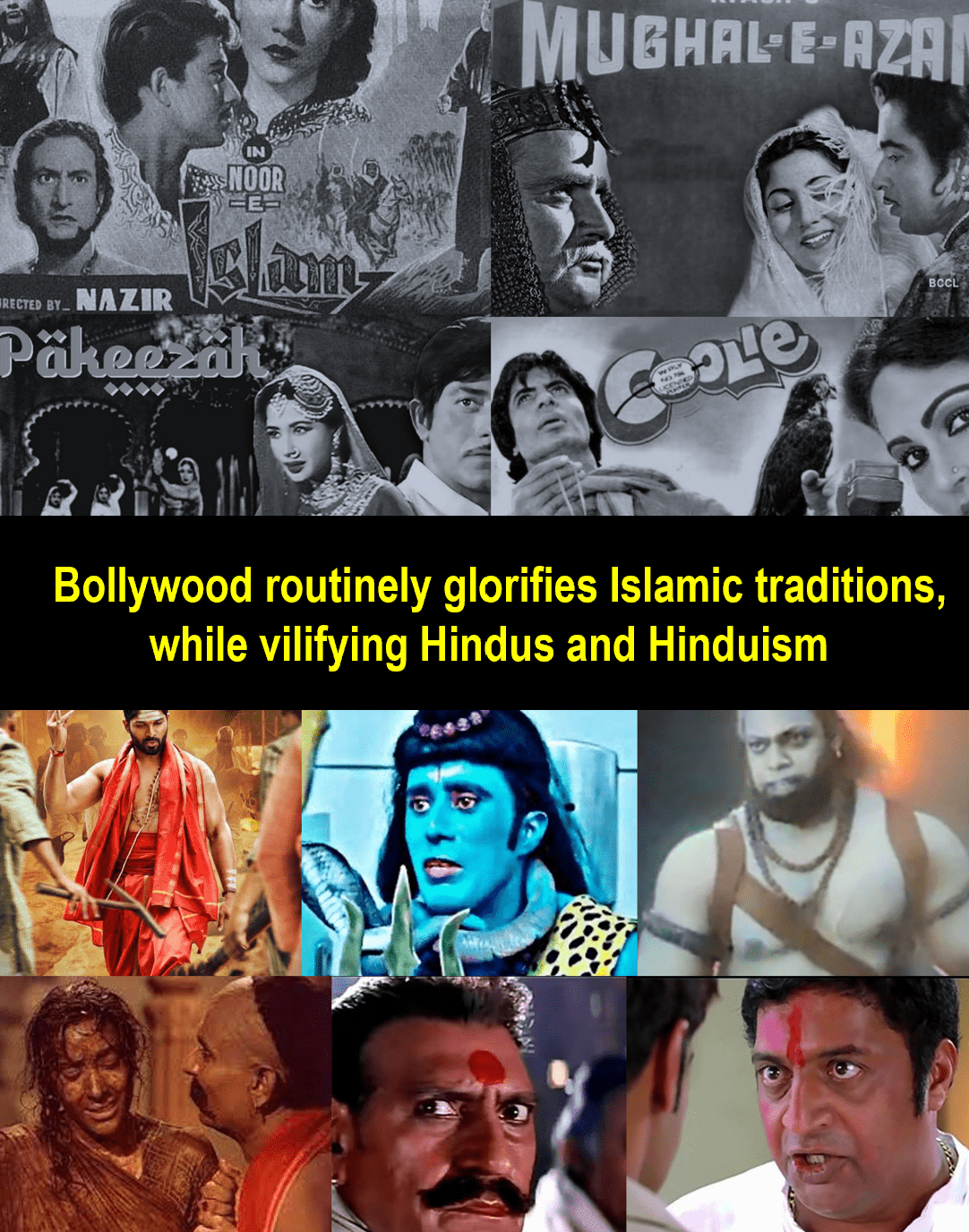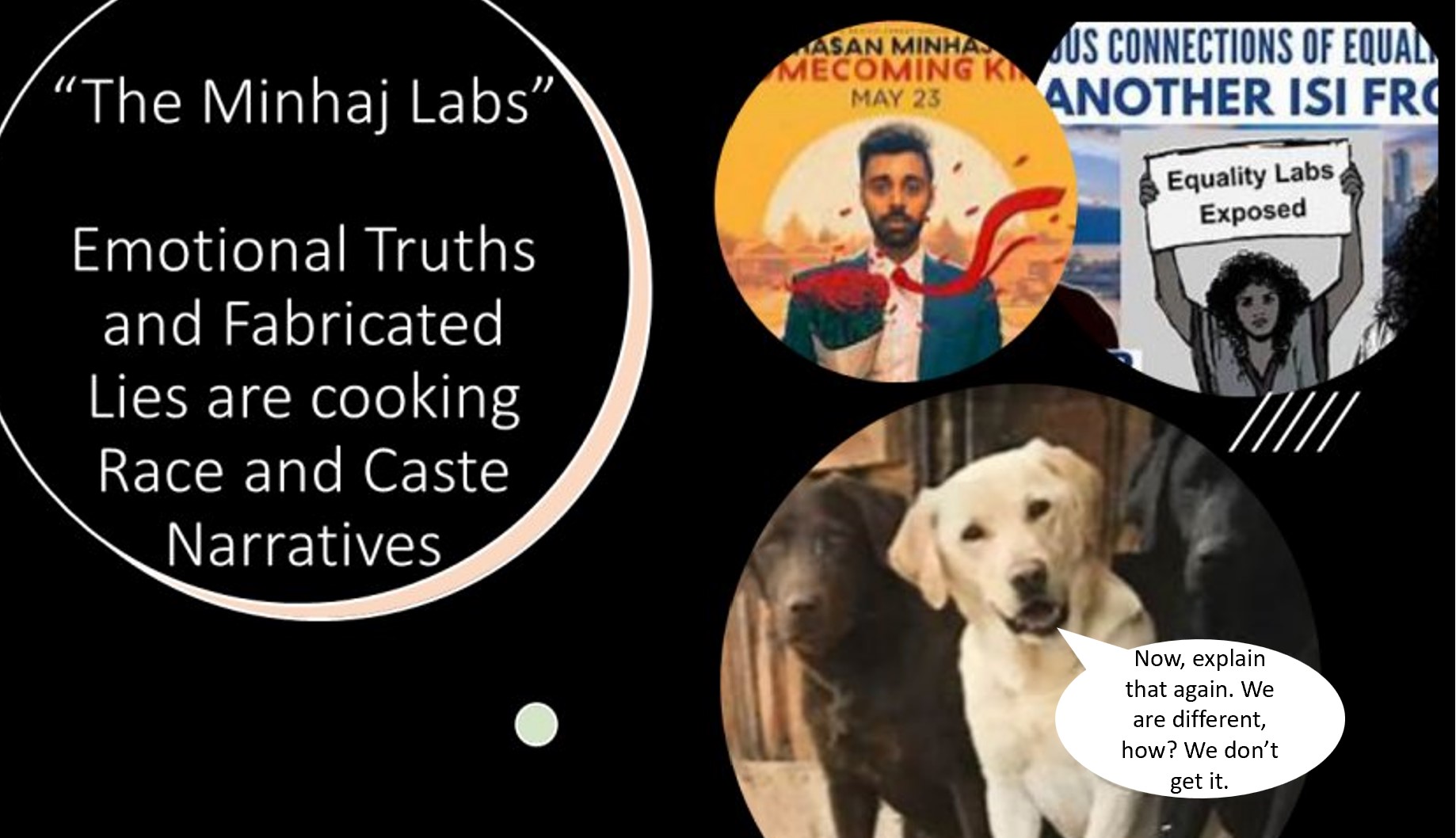The first question every Bollywood analyst is usually asked at a non-filmy party is: why is Bollywood so Hindu-phobic? Why are your films laden with so much oddball Urdu dialogues and songs? And finally, why is Bollywood so overeager to cover up for Islamists and rationalize Pakistan and its jihadi escapades while simultaneously berating India and Hindus?
 The latest mega-release from Yash Raj Films, ‘Pathaan,’ is symptomatic of all these characteristics, where incredibly, a patriotic Muslim protagonist teams up with a Pakistani ISI agent to take down a rogue Indian RAW agent bent on destroying the world. Well, any school kid with a little exposure to current affairs can pick holes in this laughable plot, yet such films keep getting made with great alacrity in Bollywood. It would be interesting to scratch the surface and look at how exactly the Hindi film industry ended up in this quagmire.
The latest mega-release from Yash Raj Films, ‘Pathaan,’ is symptomatic of all these characteristics, where incredibly, a patriotic Muslim protagonist teams up with a Pakistani ISI agent to take down a rogue Indian RAW agent bent on destroying the world. Well, any school kid with a little exposure to current affairs can pick holes in this laughable plot, yet such films keep getting made with great alacrity in Bollywood. It would be interesting to scratch the surface and look at how exactly the Hindi film industry ended up in this quagmire.
Stockholm Syndrome?
India’s film industry made its debut with the religious drama of ‘Raja Harishchandra.’ Back then, most films were simply soundless versions of holy stage dramas, and even when films began talking, they continued to leverage the stories from our epics and mythology. Soon the movie-making business spread its wings across the country, and we had regional film-making powerhouses in Chennai (then Madras), Kolkata (then Calcutta), and Lahore, besides Mumbai (then Bombay). But cometh 1947 and Bharat had to go through a terrible partition to create Pakistan. In the displacement process, several established and budding Hindu-Punjabi filmmakers were forced out of the old Punjab into the tough streets of Delhi and Mumbai. Almost everybody had a heart-tugging displacement tale. With their grandeur and prestige gone, most of these new filmmakers had to begin afresh and were left perennially saddled with this partition baggage, which never failed to lurk through their expression of art.
Could it be the Stockholm Syndrome effect at work here, with these guys using their films as a coping mechanism, wherein they developed positive feelings towards their abusers? Let’s look at a few examples. Some of the most prominent escapees from Lahore were BR Chopra, his younger brother Yash Chopra, Ramanand Sagar, and Manoj Kumar. Of all creative people, Yash Chopra milked this India-Pak and Hindu-Muslim divide the most and has probably done the maximum damage to the Hindu psyche. In his very first film as a director in 1959’s ‘Dhool ka Phool,’ he portrays a kind Muslim man bringing up an ‘illegitimate’ Hindu child; the film features the classic song that was promoted for decades as an anthem for secularism – ‘Tu Hindu Banega Na Musalman Banega, Insaan Ki Aulaad Hai, Insaan Banega.’[1] Having tasted commercial success, Chopra simply reversed his formula for his next ‘Dharmputra’ in 1961, wherein a Hindu family brings up an illegitimate Muslim child. Widely touted as the first film on ‘Hindu fundamentalism,’ this film had Shashi Kapoor playing the pivotal role of a ‘Hindu fundamentalist.’[2] Given the political environment of those days, the film won the National Award for Best Film but tanked badly at the box office.
Was there an attempt at rationalizing the role of Muslims during Partition and other riots? Indeed, Ira Bhaskar of JNU’s School of Art and Aesthetics agrees: “The Muslim in cinema was invariably a nationalist: noble and committed. The character of Nawab Badruddin, played by Ashok Kumar in ‘Dharmputra’ typifies this.”[3] Chastened by the failure of ‘Dharmputra,’ Yash Chopra stayed away from these themes until his ‘Veer Zaara’ in 2004 again boasted of a ludicrous plot of an ex-IAF pilot going into Pakistan to rescue his love and getting wrongfully jailed, until a goodwill gesture by noble Pakistan and a doughty Pakistani lawyer rescues and reunites him with his love. His production house, too, meanwhile, continued to subtly rationalize Pakistanis and Muslims regularly with offerings like ‘Ek Tha Tiger,’ ‘Tiger Zinda Hain,’ ‘War,’ ‘Pathaan,’ and so on.
Was it a case of professional jealousy against Mumbai’s established Hindu film ecosystem? Possibly. Remember that most film professionals who left for Pakistan eventually made the breadcrumb trail back to Mumbai. Dilip Kumar’s brother, Nasir Khan, tried his luck in Lahore but failed miserably and came back, although he could never find the success he craved in the Mumbai film industry, which had moved ahead without him. Likewise, producers AR Kardar and Mehboob Khan – who later made ‘Mother India,’ had to return with an egg on their faces. Those who stayed back in Pakistan – Manto, Josh Malihabadi, Meena Shorey – were soon frustrated and depressed. The fact that the most prominent studios in Lahore – Shorey Studios and Pancholi Pictures – were Hindu owned and destroyed in the Islamist rioting meant that infrastructure to make movies would always be lacking. Prominent singer Noor Jehan, too, suffered after shifting to Pakistan and remained a nondescript Urdu-Punjabi singer, while her competitor, Lata Mangeshkar, rose to global fame. Many, including music director Naushad, have condescendingly theorized how Lata Didi became the queen of playback singing only because of Noor Jehan’s absence. Never forget that Noor Jehan sang 12 war songs during the 1965 Indo-Pak war, encouraging Pakistan to destroy their archenemy India, and yet when she visited India later, Bollywood shamelessly put out a red carpet in her welcome[4].
Was it the case of ‘Stockholm Syndrome’ for other refugee filmmakers too? For a short duration, yes. Manoj Kumar, who came up the hard way from refugee camps[5], did a lot of traditional song and dance stuff until he rejected it all to bring out only India-centric patriotic content, which was on the lines of prevalent socialist themes. Ramanand Sagar, too dabbled with Urdu musicals but eventually listened to his heart and focused only on the near-honest portrayal of Hindu epics. However, the fact remains that none of them had the success, patronage, and recognition of the Chopras with their brand of secularized blockbusters.
Nehruvian Socialism
Admittedly, Jawaharlal Nehru was shrewd enough to understand the potential of movies to take his vision of secular India to the masses. Yash Chopra has been quite open about Nehru’s influence on the early filmmakers, “Nehru and his policies were always part of our sub-consciousness. He used to say that big dams and industries are the temples of modern India. We had internalized his words.”[6] Many films of those decades – including BR Chopra’s, were filled with shots of big dams and roads being constructed. Songs such as ‘Saathi Haath Badhana’ from 1957’s ‘Naya Daur’ are replete with emotional tugs of community sharing and camaraderie among workers, showing them as true heroes, while industrialists and businessmen were portrayed as bad guys. It was also the time of huge USSR interference in India’s internal affairs, wherein films with communist themes got rewarded with funds and overseas releases. Raj Kapoor benefited the most from this, with his films getting an easy European distribution deal after his iconic ‘Sar pe laal topi Rusi’ anthem. These films enjoyed unfettered furtherance at the media and academia levels. At the same time, they slowly and steadily kept tarring the image of Hindu religious believers, temple priests, Hindu customs, and rituals with a dark brush.
Mind you, Nehru would also tolerate no defiance of his stature as a great statesman. In 1951, he promptly jailed Bollywood lyricist Majrooh Sultanpuri for comparing him to Hitler and branding him as “Commonwealth ka das”[7]. Evidently, Congress took all steps to keep Bollywood in check and compliant with its agenda. When MS Sathyu’s partition film, ‘Garam Hava’, got stuck at the Censors for eight months, it was a message to the industry to stay away from this subject. Why? Because any honest film examining the Partition would have shown the deaths of millions of Hindus while blaming Congress for the Partition, which would have only strengthened the hands of Congress’ opposition.
Islamist-Leftist Alliance

The pseudo-secularization of Bollywood had begun in earnest in 1936, when the prejudiced brain of Sir Syed Ahmed Khan – father of the two-nation theory and promoter of Aligarh Muslim University, brought forth an organization to control the intellectual narrative, called the ‘Anjuman Tarraqi Pasand Mussanafin-e-Hind.’ For broader coverage, this bunch soon morphed into a leftist cult called the ‘Progressive Writers Association’ (PWA), which included Faiz, Manto, Rajinder Singh Bedi, Sahir Ludhianvi, Amrita Pritam, etc. Later, in 1943, the Communist Party of India under PC Joshi took the same PWA members and birthed a bigger entity called the Indian People’s Theatre Association (IPTA) boasting of Bimal Roy, Chetan Anand, Prithvi Raj Kapoor, Balraj Sahni, Kaifi Azmi, Utpal Dutt & so on[8]. Like most Communist activities, IPTA too was a deceptive front for their naked propaganda – first via theater and then via cinema. It was here that the Left got deeply rooted in Bollywood. Even now, we have Directors like Vishal Bharadwaj who claim, “If I am not a leftist, I am not an artist.”[9] Soon, the Left ecosystem made it a priority to mock all religious and classic movie themes as C-grade stuff. In contrast, movies with Leftist themes were pushed up as mainstream and art cinema, worthy of entry into foreign festivals and award ceremonies. The Left knew very well that the more they demeaned and demonized Hindu elements in their films, the more the chances of the audience staying bewitched in awe of their deracinated modernity and far away from political parties like the Jan Sangh.
So instead of ‘Pauranic’ historicals, they pushed in several costume dramas on Mughal, Arabic, or Islamic themes, from ‘Mughal-e-Azam’ to ‘Thieves of Baghdad’ to ‘Alibaba aur Chaalis Chor.’ Consequently, one would never find the so-called Bollywood A-listers doing a portrayal of Lord Rama or Krishna or Hanuman ji in a Hindi film. At the same time, one can see them all – Amitabh Bachchan, Dharmendra, Jitendra, Shatrughan Sinha, Dilip Kumar, Raj Kapoor, etc. – prancing in various Islamic-themed dramas. Contrast this with South Indian cinema, where the ‘Pauranic’ cinema was always being honored by all mainstream superstars – NTR, ANR, SVR in Telegu, Dr. Rajkumar in Kannada, and Shivaji Ganesan in Tamil. No wonder Southern cinema maintained its deep connection with the audience and is still relevant today, unlike Bollywood.
Underworld Connection
As movie budgets started edging into crores from lakhs in the early eighties, it became practically impossible for many producers to fund their projects from the accruals of their earlier successes or by selling their distribution territories in advance. Financial institutions have always stayed clear of funding movies, and since the business was all about cash, film producers had to go knocking at the doors of underworld dons, who hovered around the industry, lured by its glamour. Soon, the gangs got entrenched into the entire ecosystem – deciding the allocation of major projects to their favorite stars, settling all disputes, funding costly projects, availing overseas rights, etc. Initially, they did stay away from setting the tone of the content and storyline, but once the underworld moved from Mumbai to Dubai to Karachi, it was evident that only pseudo-secular movies that towed their line got greenlit. And since a huge part of the Indian underworld was under the thumb of Pakistan’s ISI, Bollywood – India’s biggest cultural arm, got twisted at will by Pakistan and its proxies in India.
Urdufication of Bollywood went in overdrive; storylines were kept in check to avoid blaming Pakistan or Muslims for anything whatsoever, and glorification of Mughals and barbarians continued unchecked – all this while Indians and Hindus were shown in poor light and Hindi as a language was left to languish. Even today, I see several aspiring singers and writers straining to learn Urdu just to ensure their survival in the industry. Almost everybody had to face the brunt of the Urdu lobby; even the greatest of them all – Lata Mangeshkar, was once snubbed by Dilip Kumar over her diction, “Urdu of Marathis is like dal and rice.” A shocked Lata Mangeshkar shunned Dilip Kumar for thirteen years till author Khushwant Singh brokered a truce[10]. One can understand Bollywood going all in with Urdu with some Punjab-based films, considering the 180 million viewership in Pakistan and the booming market in the Middle East[11], but to push the same template and the same metric for all kinds of films clearly stinks of dirty politics here.
Impact on Indian Psyche
The question that everybody must ponder is: Were the Bollywood machinations successful in changing the mindset of its audience?
Well, a study was done by IIM-A to ascertain the effects of stereotypicality in Bollywood, and the results were nothing less than shocking.[12] They found that the majority of Indians were projected as narrow-minded, conservative, and bigoted in the movies. In contrast, a majority of the Pakistanis were depicted as open-minded and non-discriminating. There’s more. In 78% of the movies, promiscuous women had a Christian name; 58% of the corrupt politicians in films had a Hindu Brahmin last name, and 62% of the corrupt businessmen in films had a Vaishya last name; 74% of the movies presented Sikhs as laughable. On the other hand, 84% of the Muslims in films were shown as strongly religious and honest, even when depicted as criminals.
What about the audience’s acceptance? How much of this Goebbelsian propaganda actually worked? Here comes the shocker: when this data was shown to 150 school students, 94% felt that these stereotypical representations were absolutely authentic. Just imagine the generational damage done by Bollywood!
Looking ahead
Luckily, things have been mending since 2014. Demonetization has meant that cash financing and money laundering are at a minimum. Post-pandemic, the horrible death of actor Sushant Singh Rajput shocked the audiences to their bones and forced them to rethink their patronage of this cesspool. Since then, the Indian audience has largely supported only nationalistic content.
It is now the prerogative of the artists to grow a spine and say no to all the heinous proceedings that have dominated Bollywood’s messaging. Actor Nana Patekar had the gumption to say no to all projects that featured Mumbai bomb-blasts-accused Sanjay Dutt. He lost millions in performance fees but gained enormous public goodwill. Music director and playback singer Narayan Parasuram refused to accept the Filmfare award and perform in their event in 2001, as it was sponsored by a tobacco company, Manikchand. Again, his nationalist creds kept him from hitting the top tier, but he has no qualms about it. Mind you, even Lata Mangeshkar had refused to accept the Filmfare trophy in 1958 for ‘Madhumati’ as the trophy was shaped in the form of a naked girl with no clothes on, and Lata Didi’s cultural sensitivity forbade her from accepting it.[13] Did her boycott work? Yes, the organizers finally caved in and covered the trophy before presenting it to her.
What is the moral of the story? All it needs is a few good people with the courage to make a dent. Till then, the only blockbuster thing about Bollywood will be its bigotry!
Citations
[1] Wikipedia. Accessed June 27, 2023. https://en.wikipedia.org/wiki/Dhool_Ka_Phool
[2] Wikipedia. Accessed June 27, 2023. https://en.wikipedia.org/wiki/Dharmputra
[3] “Nehru’s vision…” 2009. Times of India. https://web.archive.org/web/20130513230400/http://articles.timesofindia.indiatimes.com/2009-11-16/delhi/28068204_1_secularism-yash-chopra-big-dams
[4] Parasuraman, Prathyush. 2022. “The Artists and Art We Lost Due To Partition.” Film Companion. https://www.filmcompanion.in/features/india-independence-day-the-artists-and-art-we-lost-due-to-partition-noor-jehan-saadat-hasan-manto
[5] Hindustan Times Desk. 2021. “When Manoj Kumar recalled trauma of Partition: ‘Father made me swear not to resort to violence’ | Bollywood.” Hindustan Times. https://www.hindustantimes.com/entertainment/bollywood/when-manoj-kumar-recalled-trauma-of-partition-father-made-me-swear-not-to-resort-to-violence-101629004848532.html
[6] “Nehru’s vision…” 2009. Times of India. https://web.archive.org/web/20130513230400/http://articles.timesofindia.indiatimes.com/2009-11-16/delhi/28068204_1_secularism-yash-chopra-big-dams
[7] Pothukuchi, Madhavi. 2019. “Jailed for anti-Nehru poem & celebrated for Bollywood songs, Majrooh Sultanpuri had it all.” ThePrint. https://theprint.in/theprint-profile/jailed-for-anti-nehru-poem-celebrated-for-bollywood-songs-majrooh-sultanpuri-had-it-all/299167/
[8] Daily Pioneer 2022. “How CPI’s politics sapped IPTA of its vitality.” https://www.dailypioneer.com/2022/columnists/how-cpi—s-politics-sapped-ipta-of-its-vitality.html
[9] The Hindu 2023. “If I am not a leftist, I am not an artist.” https://www.thehindu.com/features/metroplus/If-I-am-not-a-leftist-I-am-not-an-artist-Vishal-Bhardwaj/article59828935.ece
[10] Koul, Oshine. 2022. “When Dilip Kumar Allegedly Offended Lata Mangeshkar by Saying ‘Urdu Of Marathis Is Like Dal And Rice’ & She Didn’t Speak To Him For 13 Years.” Koimoi. https://www.koimoi.com/bollywood-news/when-dilip-kumar-allegedly-offended-lata-mangeshkar-by-saying-urdu-of-marathis-is-like-dal-and-rice-she-didnt-speak-to-him-for-13-years/
[11] Mathew, James. 2019. “Gulf region emerging as the top overseas market for Bollywood films.” Arabian Business. https://www.arabianbusiness.com/industries/media/415846-gulf-region-emerging-as-top-overseas-market-for-bollywood-films
[12] Sharma, Dheeraj. 2023. “Stereotypicality in Indian cinema is not a healthy trend.” Hindustan Times. https://www.hindustantimes.com/editorials/stereotypicality-in-indian-cinema-is-not-a-healthy-trend/story-y6SG1xuOvBb0cZfWJpUg0H.html?fbclid=IwAR18gHfnGkwfKuFrwv_uWbPom7Ty62wm0pNcRf2bXeRCQiNrtOl_s-CiSHk
[13] HT Desk. 2022. “Why Lata Mangeshkar refused to accept her Filmfare Awards trophy in 1958.” Hindustan Times. https://www.hindustantimes.com/entertainment/music/why-lata-mangeshkar-refused-to-accept-her-filmfare-awards-trophy-in-1958-for-her-song-aaja-re-pardesi-101653988306620.html







